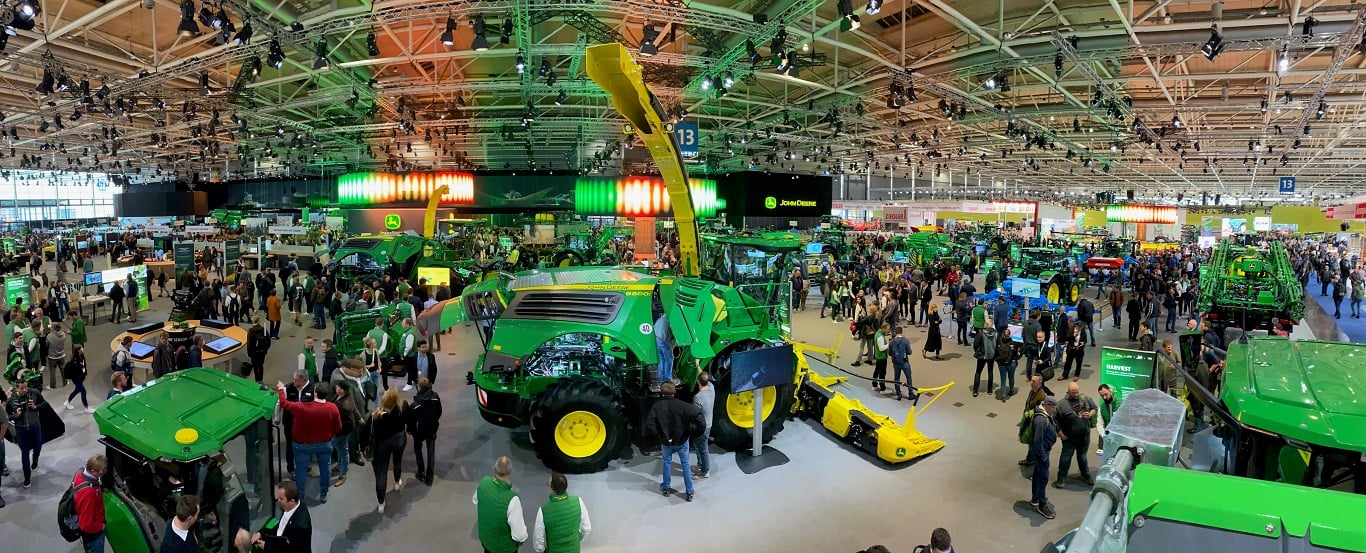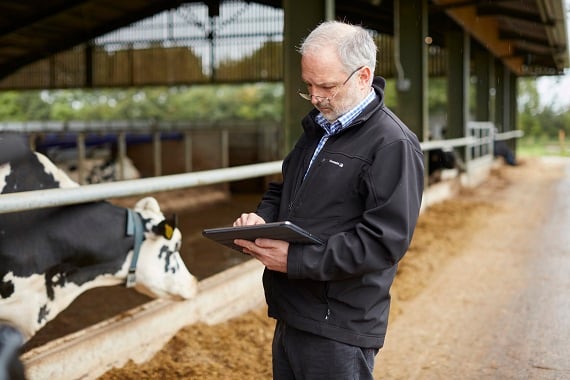A glimpse into the future of agriculture

By invitation from Agri-TechE, Charlie Yorke, Propositions Manager at NFU Mutual, reports on trends in farming technology from Agritechnica 2023, the major annual agricultural machinery exhibition.
Farmers are increasingly making use of new technologies to improve efficiency, reduce costs, and enhance overall farm management.
Technology does not necessarily need to be extravagant. It can range from simple technologies like RFID ear tags, and CCTV through to using an online data system for farm administration.
But an investment in the right technology can make a huge difference at a time when financial pressures, a growing global population, and the need for sustainable agriculture are compelling farmers to seek innovative ways to increase productivity. At the same time, government initiatives, subsidies, and regulatory support are also contributing to the acceleration of Agri-Tech adoption.
Additionally, the increasing availability and affordability of advanced technologies is making them accessible to a broader range of farmers.
Trends in Agri-Tech
At NFU Mutual, we help farmers understand the opportunities and risks posed by technology so they can make the right decisions. I was recently invited to attend Agritechnica as part of a mission by Agri-TechE. For those that aren’t aware, Agritechnica is an agricultural machinery exhibition in Germany that attracts more than 400,000 visitors. I wanted to discover the latest trends and find out more about the future technology that can offer a competitive edge to UK farmers during challenging economic times.
Agritechnica unveiled its theme centered around a global agricultural sector transitioning towards sustainability, with a deep focus on achieving "Net Zero" emissions. Manufacturers exhibited strides in alternative fuels, featuring innovations such as electric driverless tractors and methane/hydrogen-powered platforms. However, the pivot towards electrification posed challenges (particularly in adapting electric power for large attachments), prompting a rethink in how this could develop further to support farmers.
In parallel, safety and risk management took centre stage in many conversations I had, emphasising efforts to enhance machine interactions. Manufacturers acknowledged the pressing issue of rural crime, specifically GPS thefts, and responded with investments in data, tools, and systems to counteract such incidents. This experience at Agritechnica underscored the industry's dedication to sustainability, innovation, and safety, charting a dynamic course for the future of agriculture.
In the lead up to Agritechnica, I came across a fantastic article by Professor Stefan Böttinger from the University of Hohenheim, he was summarising the trends in agricultural engineering in 2023. In an attempt to summarise Professor Stefan Böttinger's blog, it highlights:
- Advancements in machinery efficiency: Intelligent machine concepts are improving work rates, while electric drives are enhancing machine dynamics and reducing CO2 emissions. Cameras and sensors are simplifying machine operation, ensuring consistently high-quality work through assistance systems and automation.
- Fertilisation technology: Efficiency, environmental protection, and resource conservation are key, alongside automation technology integration and operational simplifications, with innovations in centrifugal and pneumatic fertiliser spreaders, as well as in the application of manure.
- Drilling and sowing: The focus here is on simplicity of operation, uniform seed bed preparation, and precise seed depth placement. Row seeding and precision seeding systems, including automatic coulter pressure adjustment, are gaining significance. Innovations also focus on simultaneous seed application to meet the demands of multiple crops.
- Plant protection: Efficiency gains are in focus, with front-mounted tank systems, increased container volumes, and self-propelled vehicles. Camera-controlled hoes and spot application enhance precision, helping cut the use of crop protection agents.
- Autonomous systems and nozzle technology: There are diverse autonomous solutions under development to improve efficiency and ease of use. Pulse width-modulated nozzles with reliable operation and various options are now available.
- Tractors: There is a focus on alternative fuels, with improvements in Liquefied Natural Gas engine concepts and battery technology, while fuel cell drives are still in their initial stages. Gearboxes are developing, accompanied by improvements in vehicle technology and comfort.
- Combine harvesters: Innovations centre around threshing, separating, power density, and automation. Harvesting headers adaptable to diverse conditions and increased power density are gaining momentum. Control technologies and semi-automated calibration technologies enhance performance stability and work quality on flat and sloping terrains.
- Potato farming: Optical sorting systems are increasingly popular, while other innovations include machines to pull up the plants, using heat to kill weeds, and electricity to reduce plant remains without using chemicals. Combined units for soil tillage, planting, and ridging tools offer versatility in adapting to changing conditions.
- Sugar beet harvesting: Self-propelled beet harvesters are being improved for lower vehicle weights, extended life, and cost savings. Telemetry support, integrated weighing systems, and sensor-controlled automation of lifting tools aim to optimise the process chain, ensuring monitoring and help in maintenance and service.
- Feed harvesting: Developments focus on handling the harvested crop according to its intended use and reducing drivers' workload. Innovations range from front-mounted mower control adjustments to the cutting qualities of self-loading trailers, round balers with variable bale chambers, and goals for forage harvesters to ensure consistent cutting qualities and high throughput.
- Digital systems and IT: The overarching goal is to optimise entire production systems while enhancing work performance and quality, and innovations span tramline planning, machine automation, management systems, apps, and irrigation, crop protection, and fertilisation management.
Supporting farmers as they navigate the right Agri-Tech
I hope my reflections helps provide some context on developments in what is clearly a fast-developing and exciting market, full of opportunities.
Yet, it also presents challenges to farmers – it’s not easy to find the right, cost-effective Agri-Tech solutions that align with your needs.
Agri-Tech is reshaping the future of farming, and NFU Mutual will remain at the forefront of supporting farmers through this transformative journey.
This includes helping you put in place the right insurance coverage tailored to the risks associated with emerging technologies; and ensuring you can confidently embrace innovation without compromising the security of your operations.
By understanding the intricacies of emerging technologies, collaborating with industry stakeholders, and tailoring insurance solutions to meet evolving needs, NFU Mutual will play a vital role in ensuring the sustainability and success of the agricultural sector.

If you’re thinking of adopting new technology on your farm, we’d encourage you to speak to your local agency office, either by requesting a call back or by finding your local agency office.